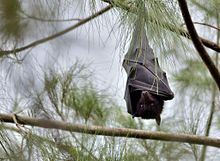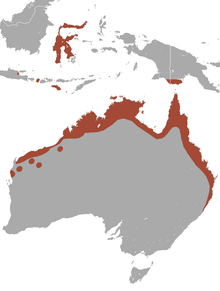Black Flying Fox
| Black flying fox | |
|---|---|
 |
|
| Scientific classification | |
| Kingdom: | Animalia |
| Phylum: | Chordata |
| Class: | Mammalia |
| Order: | Chiroptera |
| Family: | Pteropodidae |
| Genus: | Pteropus |
| Species: | P. alecto |
| Binomial name | |
|
Pteropus alecto Temminck, 1837 |
|
| Subspecies | |
|
P. a. alecto |
|
 |
|
| Black flying fox range | |
P. a. alecto
P. a. aterrimus
P. a. gouldi
P. a. morio
The black flying fox or black fruit bat (Pteropus alecto) is a bat in the family Pteropodidae. It is among the largest bats in the world, but is considerably smaller than the largest species in its genus, Pteropus. The black flying fox is native to Australia, Papua New Guinea, and Indonesia. It is not a threatened species.
Juvenile specimens of this species from Moa Island in Torres Strait have been described as a separate species, Pteropus banakrisi. This supposed species was known as the "Torresian flying fox" or "Moa Island fruit bat".
The black flying fox has short, black hair with a contrasting reddish-brown mantle, and a mean forearm length of 164 mm (6.46 in) and a mean weight of 710 g (1.57 lb). It is one of the largest bat species in the world, and has a wingspan of more than 1 m.
Black flying foxes are native to Australia (New South Wales, Queensland, Northern Territory and Western Australia), Papua New Guinea (Western Province) and Indonesia (West Papua, Sulawesi, Sumba, and Savu).
During the day, individuals reside in large roosts (colonies or 'camps') consisting of hundreds to tens of thousands of individuals. They sometimes share their roosts with the grey-headed flying fox (Pteropus poliocephalus), the spectacled flying fox (P. conspicillatus), and/or the little red flying fox (P. scapulatus). They roost in mangroves, paperbark swamps, patches of rainforest and bamboo forests, and very rarely in caves or underneath overhangs.
...
Wikipedia

